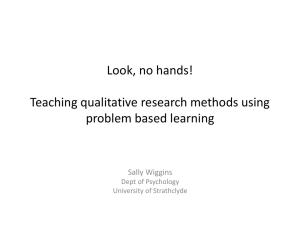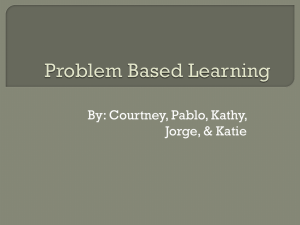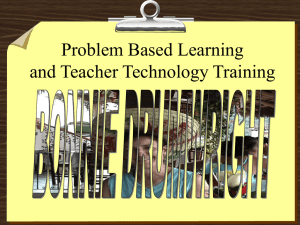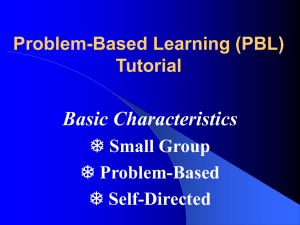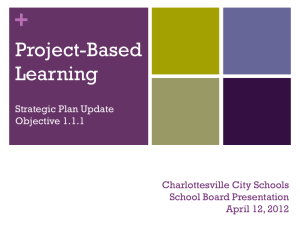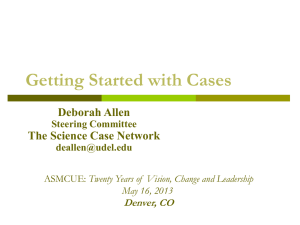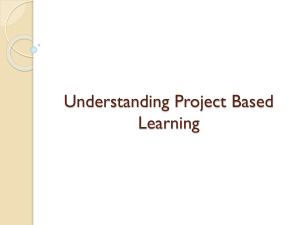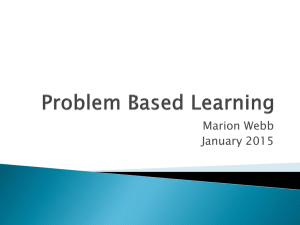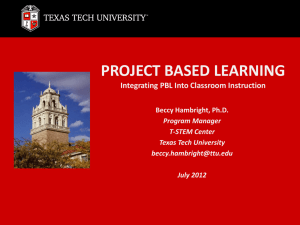Problem-Based Learning (PBL) approach
advertisement
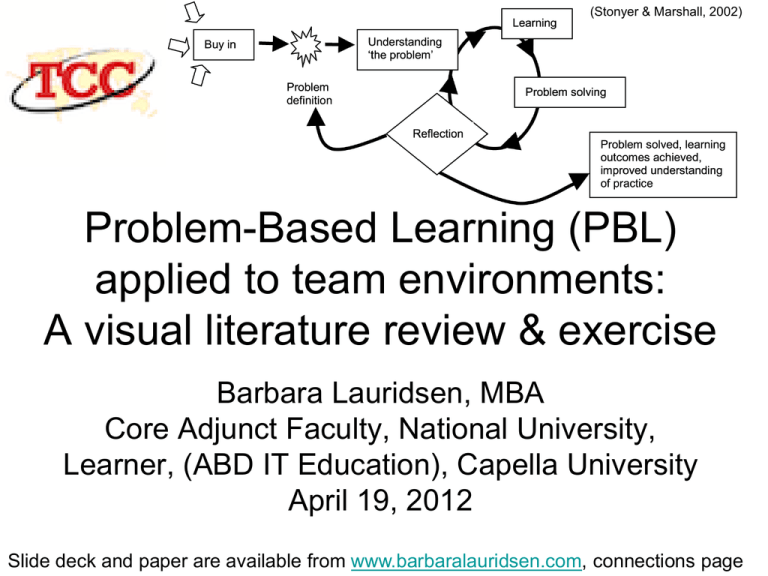
(Stonyer & Marshall, 2002) Problem-Based Learning (PBL) applied to team environments: A visual literature review & exercise Barbara Lauridsen, MBA Core Adjunct Faculty, National University, Learner, (ABD IT Education), Capella University April 19, 2012 Slide deck and paper are available from www.barbaralauridsen.com, connections page Problem-Based Learning (sampling of definitions) …an inquiry-based pedagogy “best rooted in sound understanding of the psychological processes of problem solving and the development of cognition” (Tan, 2007, p. 101). …a process of moving toward knowledge while solving a problem (Barrows & Tambyln, 1980) in which learners develop their own position on a problem and develop meaningful solutions. Learning is constructed by the learners but facilitated by an instructor acting as coach (Igo, Moore, Ramsey, & Ricketts, 2008). Problem-Based Learning (sampling of definitions) …an instructional method focusing on a problem as the “root of learning” which is facilitated by a trained tutor (Kennedy, 2007). …a cyclical situation in which learners collectively solve an “ill-structured, complex problem” accessing prior knowledge and conduct research and devises an action plan. For online PBL, a group works collaboratively across distance including synchronous or asynchronous communications and which has “constructivist epistemology as it foundation” (Sims, 2009, p. 8, 13). Problem-Based Learning (sampling of definitions) …an education approach that reflects learning directions of today, emphasizing “real-life vignettes, self-directed learning and co-operative learning together with other students in small groups,” (Hammar, 2008, p. 514). …“a student-centered pedagogy, offers a strong framework upon which to build a curriculum that will teach our students the necessary problem solving and critical thinking skills to solve the complex problems of the future” (James Madison University, School of Engineering). Problem-Based Learning (PBL) (elements in common) • student-centered, facilitator/coach guided • an educational strategy involving authentic, “real world” scenarios • problems are complex, significant, engage critical thinking of small teams • activates team members’ prior knowledge, builds new knowledge • F2F … becoming virtual or blended Donnelly’s 2009 study for blended PBL • …”important to seek best practices for how to combine instructional strategies in face-to-face and computer-mediated environments that take advantage of the strengths of each” … “to establish, in a PBL tutorial setting, the factors that govern the success of blended PBL” … “opportunity to dialogue with a range of international experts” (Donnelly, 2009, pp. 548-549). Donnelly, R. (2009). Interaction and transformation in virtual problem-based learning communities. Proceedings Of The IADIS International Conference On WWW/Internet, 548-549. Donnelly’s 2009 elements of blended PBL Learning Design Tasks Blend of Web 2.0 Technologies Description …activities, problems and Wikis, interactions used to Blogs, engage the learners, on Concept Maps which learning is based Resources …content, information, and resources with which the learners interact, upon which learning is based Discussion Boards, Podcasts, Social Bookmarking Supports …scaffolds, structures, Live Classroom, Micro-blogging on Twitter encouragements, motivations, assistances and connections used to support learning Donnelly, R. (2009). Interaction and transformation in virtual problem-based learning communities. Proceedings Of The IADIS International Conference On WWW/Internet, 548-549. Challenges “At all stages of education our challenge is to enable students to act out the problems and issues under discussion and make decisions about them based on a more personal understanding of their nature and implications” (Jaques and Salmon 2007, p. 139). Cited in Hahn, I. (2009). Enhancing the outcome problem-based teamwork using social software. Proceedings Of The IADIS International Conference On WWW/Internet, 407-410. Challenges Tutors can support multiple sessions for ProblemBased groups using asynchronous social software (Hahn, 2009): • instant messaging, possibility for multi-user chat, • forums, during group meetings or presentations, • wikis, iterative communication, automated minutes, track collaborations, recordings, commenting on articles, text editing (version control), presenting • blogs, FAQs, commenting on online articles, menu bar features, embedded links, blogroll Hahn, I. (2009). Enhancing the outcome problem-based teamwork using social software. Proceedings Of The IADIS International Conference On WWW/Internet, 407-410. Challenges “To improve engineering education, it is essential that curricula bring students to high levels of cognitive development by exposing them to real-world problem solving. Undergraduate research and industry experiences provide a strong basis for our students to learn these essential, problem-based, and globally competitive skills” (National Science Foundation, “NSF Career Project”). James Madison University, School of Engineering, http://www.jmu.edu/engineering/research/nsfcareer.html 2 pitfalls of PBL practice (1) a poor classification of what constitutes PBL experiences (2) limited assessment studies grounded on strong methodology Reason? PBL practice develops skills that are difficult to measure. (James Madison University, School of Engineering) James Madison University, School of Engineering, http://www.jmu.edu/engineering/research/underengedu.html Classifying Problems James Madison University, School of Engineering, http://www.jmu.edu/engineering/research/underengedu.html Problem Dynamics Problem-based double-loop learning Yeo, R. K. (2007b). (Re)viewing problem-based learning: An exploratory study on the perceptions of its applicability to the workplace. Journal of Managerial Psychology, 22(4), 369-391. Insight … (our incentive today)… ‘‘ The nature of peer tutoring and knowledge sharing in PBL provides a repository of information through various systematized activities to facilitate shared learning ’’ (Yoe, 2007, p. 308) Yeo, R. K. (2007a). Turning to the problem is the answer to the question of how you can learn faster than others: applying PBL at work. Industrial and Commercial Training, 39(6), 307. Learning Networks Expansion of learning networks through PBL (Yoe, 2007a, p. 309) Learning Networks … doing.. …a set of actions, decision making, problem solving, activation of hidden knowledge…. Expansion of learning networks through PBL (Yoe, 2007a, p. 309) Learning Networks … doing.. …shared experience, increasing level of collective knowledge, exploring & learn by reflecting & adjusting each experience… Expansion of learning networks through PBL (Yoe, 2007a, p. 309) … socializing … Learning Networks …process of socializing in situations of team learning and problem solving…. Expansion of learning networks through PBL (Yoe, 2007a, p. 309) … socializing … Learning Networks …nurturing a collective mindfulness of problems and issues faced… Expansion of learning networks through PBL (Yoe, 2007a, p. 309) Learning Networks … systematizing… …spontaneous learning through a series of guided activities… Expansion of learning networks through PBL (Yoe, 2007a, p. 309) Learning Networks … systematizing… Expansion of learning networks through PBL (Yoe, 2007a, p. 309) …opportunity for transfer of tacit to explicit knowledge… Walking the talk, the essence of PBL “ A typical PBL cycle involves both the thoughts and actions of employees acting as change agents. In the process, they are consciously engaged in a variety of such activities as active communication, questioning, reflection and task execution” (Yoe, 2007, p. 309). Yoe, R. (2007a). Turning to the problem is the answer to the question of how you can learn faster than others: applying PBL at work. Industrial and Commercial Training, 39(6) Mental Models McLaren et al. (2007). Do you know what you don't know? Critical reflection and concept reflection and concept mapping in an information systems strategy course. Communications of AIS, 2007(20), 892-908. Basic PBL Overview Strategic positioning within a higher education institution, with a integrated communication environment, is essential for effective introduction of the PBL approach (Stonyer & Marshall, 2002). Stonyer, H. & Marshall, L. (2002), Moving to problem-based learning in the NZ Engineering workplace, Journal of Workplace Learning,14(5), 190-197. Basic PBL Phases PBL operating in workplace context (Yeo, 2007c, p. 45, citing Kolb, 1984 and Cockerill et al. 1996) Basic PBL Phases (Adapted by Yeo, 2008, p. 324, 2007, p. 48, from Kolb 1984, Cockerill et al. 1996) Basic PBL Steps (Schmidt, 1993, p. 233) Schmidt, H. G. (1993). Foundations of problem-based learning: some explanatory notes. Medical Education, 27(0), 422-432 PBL Action Steps / Course Assessment 1. Identify and describe a problem scenario Experience, skills Knowledge, Facts, ideas 2. List what is known 3. Compose/refine problem statement Interpretation, ideas 4. List what is needed, guided search, gather new information (Masse et al., 2009, p. 3) Critical thinking 5. List possible actions, solution alternatives, “What should we do?” 6. Analyze information & ideas 7. Present findings, propose “best fit” recommendation Synthesize, evaluate, reflect PBL, effect on competencies (Biglow, 2004, p. 606) Bigelow, J. D. (2004). Using problem-based learning to develop skills in solving unstructured problems. Journal of Management Education, 28(5), 591-609. Competencies (before & after) after PBL lessons, from exit Questionnaire before PBL lessons, from intake Questionnaire Mockup of value gained for PBL lessons in solving complex problems (Adapted from Biglow, 2004, p. 606) Phases of PBL for scenario planning Phase Purpose (adapted from Allert et al. 2002) Goal Description Define a problem scenario to demonstrate course learning outcomes, establish an ultimate goal for team project. Specify Criteria Specify criteria to be met. What is the focus of the testing? How will you know when you have reached your target? Background Knowledge Identify knowledge needed to accomplish the goal. Ask experts? Research and adapt best practices? Generate Ideas Brainstorm & generate relevant and interesting ideas. Implement Solution Generate, develop and implement an adapted solution for verifying the requirements or validating the system. Reflect Evaluate & reflect on your solution(s) and on the process we went thought, the lessons learned. Generalize Conceptualize, integrate, and generalize previous knowledge about systems and new learning. Allert et al. (2002). Meta-level category ‘role’ in metadata standards for learning: instructional roles and instructional qualities of learning objects, COSIGN 2002 - The 2nd International Conference on Computational Semiotics for Games and New Media. Research issues in problem solving Table 1. Case components and cognitive scaffolds for problem solving (adapted from Jonassen, 2010, p. 12) Problem Type Case Components, Problems are … Story Problems worked examples, analogues Rule Using/ Rule Induction worked examples, analogues Decision making case studies, alternative perspectives Troubleshooting, Diagnosis solution prior experiences, alternative perspectives Strategic performance prior experiences, simulations Policy analysis case studies, prior experiences, alternative perspectives Design prior experiences, alternative perspectives Dilemmas alternative perspectives Jonassen, D. H. (2010, September-October). Research issues in problem solving. The 11th International Conference on Education Research: New Paradigm for Learning and Instruction. Multiple Learning Strategies (adapted from Bygholm & Buus, 2009, p. 19) Bygholm, A. & Buus, L. (2009). Managing the gap between curriculum based and problem based learning: Deployment of multiple learning strategies in design and delivery of online courses in computer science. International Journal of Education and development using Information and communication Technology (IJEDICT) 5(1), 13-22 Classification Framework (External Factors endemic to the problem) Problem Difficulty (based on Jonassen & Hung, 2008, as cited in Pierrakos et al., 2010) Jonassen, D. H., Hung, W. (2008) All problems are not equal: Implications for problem-based learning. The Interdisciplinary Journal of Problem-based Learning, 2(2), 6-28. Inquiry Learning Process “The discussion module of Future Learning Environment (FLE) tools has seven build-in scaffolds: problem, working theory, deepening knowledge, comment, metacomment, summary and help” (Muukkonen et al. 1999, p. 4) Muukkonen et al. (1999). Computer support for knowledge building. Brian (2010, April 19). Curious to Learn? Random Thoughts and Focused Minds: Center for Teaching & Learning. Problem-Based Learning Cycle Overview/ Assessment Mini-lecture Problem, Project, or Assignment (only when needed!) Group Discussion Whole Class Discussion Research Preparation of Group “Product” Group Discussion de Vry, J., Watson, G. & Frey, B. (2006). Modeling and assessing online discussion for faculty learning and technology development [Presentation]. Educause Problem-based learning steps PROBLEM FACTS FACTS (Data) (Data) IDEAS IDEAS (Hypothesis) (Hypothesis) LEARNING LEARNINGNEEDS NEEDS (What do we need (What do we needto to know? know? 1.1.IDENTIFY IDENTIFYPROBLEM PROBLEM Relevant Facts 2.2.GENERATE GENERATEIDEAS IDEAS 3.3.ORGANIZE ORGANIZEIDEAS IDEAS Reorganize, refine, learning needs LEARNING RESOURCES New ideas Revise, refine, record ideas 4.4.DERIVE DERIVELEARNING LEARNING NEEDS NEEDS Revise ideas? 5.5.ORGANIZE ORGANIZELEARNING LEARNING NEEDS NEEDS 6.6.TEST TESTIDEAS IDEAS Flawed or no relevant Good? Reject, or not now CONCLUSIONS / EVALUATION What have we learned? Do we need to learn more? Webquest EDUC335. (2009, February 22). Differentiated Instruction: Examples of di-strategies [Webpage]. Live PBL Exercise <about 10 minutes> • Within breakout rooms, with one member acting as moderator, to expedite, the brainstorming will be verbal and text streaming. • Scenario: A program lead has requested that a task force provide a game-plan for extending learning delivery to allow bring-your-own-device (BYOD). • What is known? Compose a first generalized problem statement, then, … after reflection, what is the risk or challenge for a shift to BYOD? • What needs to be known? Return with a problem statement… (not a solution)… to the chat box PBL Model 7 Steps 1. 2. 3. 4. 5. 6. 7. Analyze the problem scenario. List what is known. Develop a problem statement. List what is needed. List possible actions, Analyze information Present findings (summary of experience) PBL Model Step 1 1. Read and analyze the problem scenario. [1] Check your understanding of the scenario by discussing it within your breakout group. • A team effort may be more effective in isolating the key factors in this situation. • Because the scenarios are real-like problem solving situations, in a learning exercise, you will actively search [2] for information to understand and to resolve the problem. [1] Start with a exercise problem statement, expand your understanding, build a scenario or a mental model. [2] Use text book, the internet, plus prior knowledge. <today, we will only pretend to do these searches> PBL Model Step 2 2. List what is known. • Start a list of everything known from members of your group • Potentially, add knowledge that others bring (e.g. authors, classmates, learners, professors…) • Perhaps list things people think they know, with some uncertainty or some degree of confidence PBL Model Step 3 • 3. Develop a problem statement. A problem statement should come from your analysis of what you do know, constrained or represented by the “real world” stories found • In one or two sentences you should be able to describe what it is that you are trying to solve, produce, respond to, or discover. • The problem statement may be revised as new information is discovered and brought to bear on the situation. PBL Model Step 4 • 4. List what is needed. • List questions you think need to be answered to solve (or resolve) the problem or issue • Record: "What do we need to know?" • Several types of questions may be appropriate. Some questions may address concepts or principles that need to be learned in order to address the situation, • Requests for more information to guide searches that may take place on-line, in the library, or out-of-class searches, perhaps interviews. PBL Model Step 5 • 5. List possible actions. • List practical solutions, or hypotheses under the heading: "What should we do?...or What should be done?" • List actions to be taken, e.g., ask an expert (author, instructor, classmate), get on-line data & ideas, visit an eLibrary, or eJournals PBL Model Step 6 6. Analyze information. • Analyze situation information assembled. Revise problem statement to consider scope, resources or schedule. • Refine the potential learning opportunities. • At this point, your team can formulate and/or test hypotheses to explain the problem. Some problems may only require a recommended solution or opinion (based on research data) • Be practical and pragmatic. PBL Model Step 7 7. Present findings • Prepare a concise report in which you make recommendations, inferences, or other appropriate resolution of the problem based on your data and background, to support a recommendation • Note: The steps in this model may have to be visited several times. Steps two through five may be conducted concurrently. As more information is gathered, the problem statement may be refined or altered to reflect expanding understanding. PBL Model 7 Steps (review) 1. 2. 3. 4. 5. 6. 7. Analyze the problem scenario List what is known Develop a problem statement List what is needed List possible actions Analyze information Present findings (summary of experience) According to de Vry, Watson and Frey (2006) good PBL Problems: • • • • • relate to real world, motivates learners require decision-making or judgments are multi-page, multi-stage are designed for group-solving pose open-ended initial questions that encourage discussion • incorporate course content objectives, higher order thinking, other skills de Vry, J., Watson, G. & Frey, B. (2006). Modeling and assessing online discussion for faculty learning and technology development [Presentation]. EDUCAUSE. Retrieved from http://net.educause.edu/ir/library/powerpoint/MAC0634.pps Live PBL Exercise <about 10 minutes> • Within breakout rooms, with one member acting as moderator, to expedite, the brainstorming will be verbal and text streaming. • Scenario: A program lead has requested that a task force provide a game-plan for extending learning delivery to allow bring-your-own-device (BYOD). • What is known? Compose a first generalized problem statement, then, … after reflection, what is the risk or challenge for a shift to BYOD? • What needs to be known? Return with a problem statement… (not a solution)… to the chat box Brainstorming… Goal, the end result expected a good idea and experience of collaboration Customizing the scenarios, alternatives Understanding a game-plan Resources? People, technology, tools, environments… Feedback from the PBL sessions… Muukkonen et al. (1999). Computer support for knowledge building. http://mlab.uiah.fi/fle/research/eawoppaper.html Inquiry Process Pose Real Questions Find Resources Interpret Information Report Findings What do I want to know about this topic? What kinds of resources might help? How is this relevant to the question? What is the main point? What do know about the question Where do I find them? What parts support my answer? Who is the audience? How do I know it? How do I know information is valid? How does it relate to what else I know? What else is important? What do I need to know? Who is responsible for the info? What part do not support my answer? How does it connect? What could an answer be? What other info is there, to discover? Does it raise new questions? How to use media to express the message? Adapted from http://www.classroom20.com/group/inquirybasedlearning/forum/topics/relevant-research-on-inquiry? Questions? CONCLUSIONS / ASSESSMENT 1.1.IDENTIFY IDENTIFYPROBLEM PROBLEM 2.2.GENERATE GENERATEIDEAS IDEAS Good ideas? done What have we learned? How much do I understand the problem? What can I do with what I have learned? What further information can I learn through the problem? Relevant Facts 3.3.ORGANIZE ORGANIZEIDEAS IDEAS (communicate, (communicate,debate, debate,assess assess pre-concepts pre-conceptswith withexisting existing information information 4.4.DERIVE DERIVELEARNING LEARNINGNEEDS NEEDS (What (Whatdo dowe weneed needto toknow knowto toprove, prove, refine, or reject our ideas?) refine, or reject our ideas?) 5.5.ORGANIZE ORGANIZELEARNING LEARNINGNEEDS NEEDS (communicating (communicatingthe thenecessity necessityof of learning learningneeds, needs,sharing sharinglearning learning tasks) tasks) 6.6.TEST TESTIDEAS IDEAS New ideas Flawed or no relevant Good Ideas … needs more LEARNING RESOURCES Revise, refine, record ideas Adapted from Wang, Thompson, Shuler & Harvey (1999), Problem-Based Learning for Science Teacher’s Professional Development, Presented at 1999 ABETS Annual Conference, Austin Texas. http://www.linguistik-online.de/17_03/carstensenHessPict/Figure1.jpg Reject, or not now Other ideas Key References Brian (2010, April 19). Curious to Learn? Random Thoughts and Focused Minds: Center for Teaching & Learning. [Webpage]. de Vry, J., Watson, G. & Frey, B. (2006). Modeling and assessing online discussion for faculty learning and technology development [Presentation]. EDUCAUSE. Jonassen, D. H., Hung, W. (2008) All problems are not equal: Implications for problem-based learning. The Interdisciplinary Journal of Problem-based Learning, 2(2), 6-28. Pierrakos, O., Zilberberg, A., & Anderson, R. (2010). Understanding undergraduate research experiences through the lens of problem-based learning: Implications for curriculum translation. Interdisciplinary Journal Of Problem-Based Learning, 4(2), 3562. Wang, Thompson, Shuler & Harvey (1999), Problem-Based Learning for Science Teacher’s Professional Development [Presentation] 1999 ABETS Annual Conference. Webquest EDUC335. (2009, February 22). Differentiated Instruction: Examples of di-strategies [Webpage]. PBL Exercise (alternative) • Team members follow a moderator • Scenario: Your team provide an assessment of what is known about “open-ended problems” • <breakout#1> To expedite, the brainstorming will be verbal with a scribe posting keywords • <return> each team will express what is known, and type a problem statement into text chat. … • <breakout#2> Reflection what are the challenges to be faced? • <return to main room with a refined problem statement> PBL Exercise <continued> … live PBL team experience… • <breakout#3> • Discuss and reflect, what are the opportunities, challenges to be faced where open-ended is relevant now, during brainstorming a vision? • Together, refine the problem statement (putting into a scribe’s clipboard)… then, when ready, the team’s moderator can use the menu option to return members to the main room • <return> three revised problem statements will be entered into chat, and discussed
